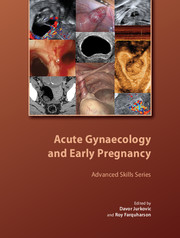Book contents
- Frontmatter
- Contents
- About the authors
- Acknowledgements
- Abbreviations
- Preface
- 1 Organisation and delivery of emergency care in early pregnancy and acute gynaecology
- 2 Epidemiology and aetiology of miscarriage and ectopic pregnancy
- 3 Diagnosis of miscarriage
- 4 Conservative and surgical management of miscarriage
- 5 Management of hyperemesis gravidarum
- 6 Diagnosis and treatment of recurrent miscarriage
- 7 Differential diagnosis and management of molar pregnancy
- 8 Drugs in early pregnancy
- 9 Diagnosis of tubal ectopic pregnancy
- 10 Conservative management of tubal ectopic pregnancy
- 11 Surgical management of tubal ectopic pregnancy
- 12 Diagnosis and management of non-tubal ectopic pregnancy
- 13 Diagnosis and management of acute pelvic pain
- 14 Management of vaginal bleeding in the acute clinical setting
- 15 Current concepts in screening and outpatient management of pelvic inflammatory disease
- 16 Diagnosis and management of haemorrhagic and septic shock
- 17 Role of minimally invasive surgery in acute gynaecology
- Index
5 - Management of hyperemesis gravidarum
Published online by Cambridge University Press: 05 July 2014
- Frontmatter
- Contents
- About the authors
- Acknowledgements
- Abbreviations
- Preface
- 1 Organisation and delivery of emergency care in early pregnancy and acute gynaecology
- 2 Epidemiology and aetiology of miscarriage and ectopic pregnancy
- 3 Diagnosis of miscarriage
- 4 Conservative and surgical management of miscarriage
- 5 Management of hyperemesis gravidarum
- 6 Diagnosis and treatment of recurrent miscarriage
- 7 Differential diagnosis and management of molar pregnancy
- 8 Drugs in early pregnancy
- 9 Diagnosis of tubal ectopic pregnancy
- 10 Conservative management of tubal ectopic pregnancy
- 11 Surgical management of tubal ectopic pregnancy
- 12 Diagnosis and management of non-tubal ectopic pregnancy
- 13 Diagnosis and management of acute pelvic pain
- 14 Management of vaginal bleeding in the acute clinical setting
- 15 Current concepts in screening and outpatient management of pelvic inflammatory disease
- 16 Diagnosis and management of haemorrhagic and septic shock
- 17 Role of minimally invasive surgery in acute gynaecology
- Index
Summary
Introduction
Nausea and vomiting are common in pregnancy, affecting 70-80% of women in early pregnancy. Up to one-third of all pregnant women have to take time off work on at least one occasion as a result of nausea and vomiting of pregnancy. However, it is generally a mild condition and tends to resolve spontaneously.
By contrast, hyperemesis gravidarum (HG) is a severe intractable form of nausea and vomiting that occurs typically in the first trimester of pregnancy, leads to fluid and electrolyte imbalances, weight loss and ketonuria and is severe enough to require hospital admission. It affects approximately 0.3-2.0% of pregnancies, typically occurring between 4 and 10 weeks of gestation, with resolution of the symptoms by 20 weeks of gestation. However, in approximately 10% of affected women the symptoms persist throughout pregnancy. Nowadays, HG rarely causes serious morbidity, but before the advent of intravenous fluids for treatment in the 1930s the mortality rate from this condition was 159 deaths per million births in the UK.
Epidemiology
Epidemiological studies have identified that women with HG are more likely to be non-white race, younger and non-smokers with a previous or family history of the condition. They may have co-existing medical disorders and their pregnancies are more likely to be complicated by molar pregnancy, multiple gestation or Down syndrome (Table 5.1).
Aetiology
The pathophysiology of HG is poorly understood. Various endocrine, mechanical, infective and psychological factors have been implicated, although no one theory has been shown to apply to all cases.
- Type
- Chapter
- Information
- Acute Gynaecology and Early Pregnancy , pp. 49 - 62Publisher: Cambridge University PressPrint publication year: 2011

